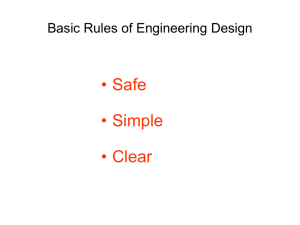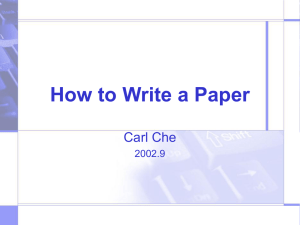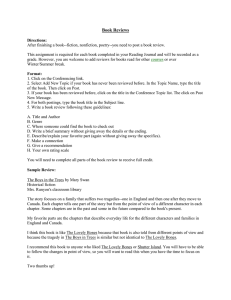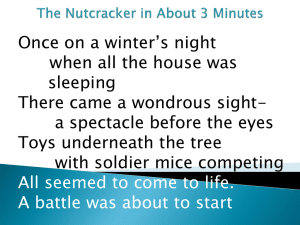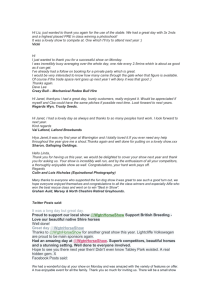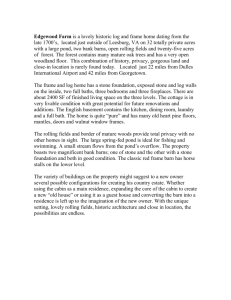Clicks, Flicks and Tricks: Adapting New and Adopting Old Innovations
advertisement
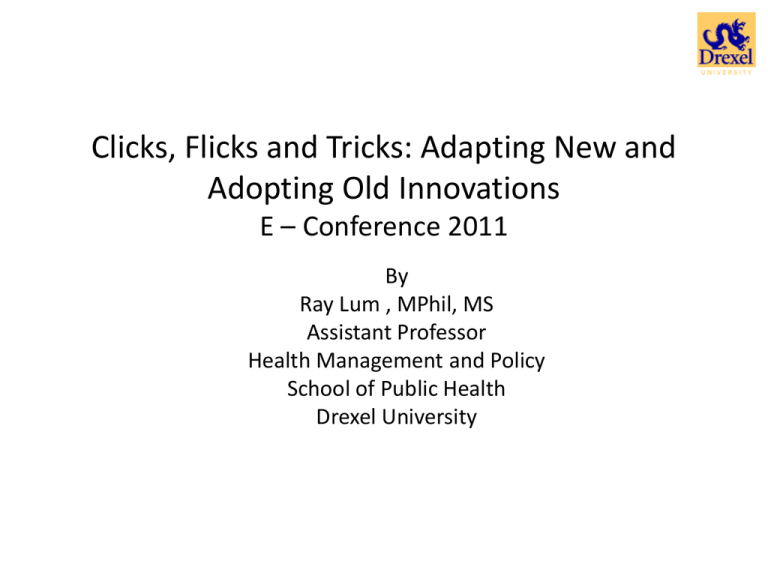
Clicks, Flicks and Tricks: Adapting New and Adopting Old Innovations E – Conference 2011 By Ray Lum , MPhil, MS Assistant Professor Health Management and Policy School of Public Health Drexel University Clicks, Flicks and Tricks: Adapting New and Adopting Old Innovations E – Conference 2011 By Ray Lum , MPhil, MS Assistant Professor Health Management and Policy School of Public Health Drexel University Acknowledgement Rob Rasberry, Gary San Angel, Sean Brown, Joe Zang, Cyndi Schaffer, Lynn Ryan, Levi Moore, Michael Shelmet, Julie Allmayer – Drexel IRT Team Caroline Feenan – Blackboard Systems Administrator, CNHP, Drexel University Abstract As faculty and students struggle to use generations of online tools to enhance their learning outcomes, they are often challenged to integrate the content of the course while they build their capacity to use the online tools effectively within the context of their Learning Management System. The convergence of the adaption of new and adoption of old waves of innovative online tools would foster robust shared learning environment. This would further allow capacity building and confidence for generations of innovative tools in a steady and seamless manner. This presentation demonstrates best practices from the convergence of the evolution (1) from tradition textbooks to online modules with video support for course materials, (2) of Faculty-student interactions from blogs/journals to online video conferencing and digital archiving (3) from traditional paper assignment submissions to online polling/surveys and the divergence (4) from faculty centered to students centered presentations through the use of clickers and video and (5) the reformulation of a new education paradigm which converges traits of face-to-face, hybrid and online courses. Outline 1) 2) 3) 4) 5) 6) Diffusion of Innovation Principles 1st Generation Online Innovations 2nd Generation Online Innovations Assessment and Measures within Brain Based Context Diffusion of Innovation Cases 1) Platform 2) Liquid Network 3) Serendipity – 1st and 2nd Generations 7) References 1.0 Diffusion of Innovation Curve Source: NYTimes: http://www.nytimes.com/imagepages/2008/02/10/opinion/10op.graphic.ready.html- 1.1 Diffusion of Innovation from Courses F2F - Innovation Amount of Innovation Adaption of Innovation * Hybrid – Health Mgmt •Liquid Network •Serendipity •Platform F2F – Health Mgmt F2F – Health Policy *Source Johnson, Steven (2010).Where Good Ideas Come From: Natural History of Innovation, New York: Riverhead Books Period of time Taught 2.0 Principles for Assessing Learning Characteristic of Learning Environment Pedagogy Course and Learning Management System Design 8 2.1 Principle: Quality Matters Rubric •Course Overview and Introduction Characteristic •Learning Objectives of Learning Environment •Assessment and Measurement •Resources and Materials Pedadogy •Learner Engagement •Course Technology Course and Learning •Learner Support Management System Design •Accessibility Source: http://www.qualitymatters.org 9 2.2 Principle: Pedagogy •F2F •Hybrid •Online •Lecture / Didactic •Seminar •Case Base •Problem Base •Co-teaching •Directing Characteristic of Learning Environment Pedadogy Course and Learning Management System Design Source: http://www.qualitymatters.org 10 2.3 Principle: Characteristics of Meaningful Learning as Guidelines for Designing Constructivist Learning Environments Active Constructive Collaborative Intentional Complex Contextual Conversational Reflective Characteristic of Learning Environment Pedagogy Course and Learning Management System Design Source: Jonassen, D . ( n.d. ) Design of Constructivist Learning Environments . [ http://tiger.coe.missouri.edu/~jonassen/courses/CLE/index.html ] 11 2.4 Principle – Brain based learning Brain Based Learning •Information Literacy •Scientific Inquiry •Personal Development •Social Fluency •Artistic Expression Source: Jensen, Eric (2008). Brain Based Learning: The New Teaching Paradigm. Thousand Oaks, CA: Corwin Press. 2.5 Principle – Brain based assessment Brain Based Assessment •Content •Processing •Emotion •Context •Embodiment Source: Jensen, Eric (2008). Brain Based Learning: The New Teaching Paradigm. Thousand Oaks, CA: Corwin Press. 2.6 Types of Brain Based Assessment • • • • • • • • • Media Creation Pre & Post test Demonstration/student teacher Model Making Commercial Short-films Case study problem Personal goals Mind mapping Group discussions Source: Jensen, Eric (2008). Brain Based Learning: The New Teaching Paradigm. Thousand Oaks, CA: Corwin Press. 3.0 1st Generation Online Innovations Course Course Administrat Design ion Course Pedagogy Blog WIKI Discussion Board Online Assessments Course Assessment/ Outcoms Personal Journal on Learning Signing up of activities Student Centered Learning Assessment Pre and Post Assessments 15 4.0 2nd Generation Online Innovations Course Course Administrat Design ion Course Pedagogy Adobe Connect Virtual Office Adobe Connect Adobe Connect Media Site Video E-mail for Survey Response Video Capture Polling Media Site Video / Polling/Smartboard Class Preparation Student Centered Learning Course Assessment/ Outcoms Innovation Concept Serendipity Project Presentation Liquid Network Assessment Liquid Network Project Presentation Platforming 16 5.0 Assessment and Measure on Brain Based Context Adobe Connect / Smartboard Artistic Social Influence In class Activities In class Activities Media Site Video Personal Developmnet Presenting Innovation Projects Lovely Acres Innovation Projects Lovely Acres Context Embodiment In class Activities Polling Media Site Video / Polling/ Smartboard Emotion Innovation Projects Lovely Acres Presenting Presenting Clicker Activities Clicker Activities Innovation Projects Lovely Acres Innovation Projects Lovely Acres Innovation Projects Lovely Acres 17 6.0 Diffusion of Innovation – Platform F2F - Innovation Amount of Innovation Adaption of Innovation •Liquid Network •Serendipity •Platform Hybrid – Health Mgmt F2F – Health Mgmt F2F – Health Policy Period of time Taught 6.0 D of I– Platform – Innovation Project 2008 (Media Creation & Short film) 6.0 D of I– Platform – Innovation Project 2008 (Media Creation & Short film) cont’d 6.0 D of I– Platform – Innovation Project 2008 (Media Creation & Short film) cont’d 6.0 D of I– Platform – Innovation Project 2008 (Media Creation & Short film) cont’d 6.0 D of I– Platform – Innovation Project 2008 (Media Creation & Short film) cont’d 6.0 D of I– Platform – Innovation Project 2008 (Media Creation & Short film) cont’d 6.0 D of I– Platform – Innovation Project 2008 (Media Creation & Short film) cont’d 6.0 D of I– Platform – Innovation Project 2010 (Media Creation, case study problem, model building and personal goal) cont’d 6.0 D of I– Platform – Innovation Project 2010 (Media Creation, case study problem, model building and personal goal) cont’d 6.0 D of I– Platform – Innovation Project 2010 (Media Creation, case study problem, model building and personal goal) cont’d Source: Philadelphia Social Innovation Journal Spring 2010 Edition http://www.philasocialinnovations.org/site/index.php?option=com_content&view=article&id=165:issue-3--spring-2010&catid=32:pasteditions&Itemid=86 6.0 D of I– Platform – Innovation Project 2010 (Media Creation, case study problem, model building and personal goal) cont’d 6.0 D of I– Platform – Innovation Project 2010 (Media Creation, case study problem, model building and personal goal) cont’d 6.0 D of I– Platform – Innovation Project 2010 (Media Creation, case study problem, model building and personal goal) cont’d 6.0 D of I– Platform – Innovation Project 2011 (Media Creation, case study problem, model building, personal goal, student teacher and pre and post test ) cont’d 6.0 D of I– Platform – Innovation Project 2011 (Media Creation, case study problem, model building, personal goal, student teacher and pre and post test ) cont’d 6.0 D of I– Platform – Innovation Project 2011 (Media Creation, case study problem, model building, personal goal, student teacher and pre and post test ) cont’d 6.0 D of I– Platform – Innovation Project 2011 (Media Creation, case study problem, model building, personal goal, student teacher and pre and post test ) cont’d 6.0 D of I– Platform – Innovation Project 2011 (Media Creation, case study problem, model building, personal goal, student teacher and pre and post test ) cont’d 6.0 D of I– Platform – Innovation Project 2011 (Media Creation, case study problem, model building, personal goal, student teacher and pre and post test ) cont’d 6.0 D of I– Platform – Innovation Project 2011 (Media Creation, case study problem, model building, personal goal, student teacher and pre and post test ) cont’d 6.0 D of I– Platform – Innovation Project 2011 (Media Creation, case study problem, model building, personal goal, student teacher and pre and post test ) cont’d 6.0 D of I– Platform – Innovation Project 2011 (Media Creation, case study problem, model building, personal goal, student teacher and pre and post test ) cont’d 6.0 D of I– Platform – Innovation Project 2011 (Media Creation, case study problem, model building, personal goal, student teacher ) cont’d 6.0 D of I– Platform – Innovation Project 2011 (Media Creation, case study problem, model building, personal goal, student teacher ) cont’d 6.1 Diffusion of Innovation – Liquid Network F2F - Innovation Amount of Innovation Adaption of Innovation •Liquid Network •Serendipity •Platform Hybrid – Health Mgmt F2F – Health Mgmt F2F – Health Policy Period of time Taught 6.1 D of I – Liquid Network – Lovely Acres (Emotion, Context and Embodiment) 6.1 D of I – Liquid Network – Lovely Acres (Emotion, Context and Embodiment) 6.1 D of I – Liquid Network – Lovely Acres (Emotion, Context and Embodiment) 6.1 D of I – Liquid Network – Lovely Acres (Emotion, Context and Embodiment) 6.1 D of I – Liquid Network – Lovely Acres (Emotion, Context and Embodiment) 6.1 D of I – Liquid Network – Lovely Acres (Emotion, Context and Embodiment) 6.1 D of I – Liquid Network – Lovely Acres (Emotion, Context and Embodiment) 6.1 D of I – Liquid Network – Lovely Acres (Emotion, Context and Embodiment) 6.1 D of I – Liquid Network – Lovely Acres (Emotion, Context and Embodiment) 6.1 D of I – Liquid Network – Lovely Acres (Emotion, Context and Embodiment, Artistry, Social Fluency) 6.1 D of I – Liquid Network – Lovely Acres (Emotion, Context and Embodiment, Artistry, Social Fluency) 6.1 D of I – Liquid Network – Lovely Acres (Emotion, Context and Embodiment, Artistry, Social Fluency) 6.1 D of I – Liquid Network – Lovely Acres (Emotion, Context and Embodiment, Artistry, Social Fluency) 6.1 D of I – Liquid Network – Lovely Acres (Emotion, Context and Embodiment, Artistry, Social Fluency) 6.1 D of I – Liquid Network – Lovely Acres (Emotion, Context and Embodiment, Artistry, Social Fluency and personal development) 6.1 D of I – Liquid Network – Lovely Acres (Emotion, Context and Embodiment, Artistry, Social Fluency and personal development) 6.1 D of I – Liquid Network – Economic Exercise (Context and Embodiment) 6.1 D of I – Liquid Network – Economic Exercise (Context and Embodiment) 6.1 D of I – Liquid Network – Economic Exercise (Context and Embodiment) 6.1 D of I – Liquid Network – Economic Exercise (Context and Embodiment) 6.1 D of I – Liquid Network – Economic Exercise (Context and Embodiment) 6.1 D of I – Liquid Network – Economic Exercise (Context and Embodiment) 6.1 D of I – Liquid Network – Economic Exercise (Context and Embodiment) 6.1 D of I – Liquid Network – Mind Mapping (Context) 6.1 D of I – Liquid Network – Mind Mapping Lovely Acres (Context) 6.1 D of I – Liquid Network – Mind Mapping Lovely Acres (Context and Artistry) 6.1 D of I – Liquid Network – Mind Mapping Lovely Acres (Context and Artistry) 6.1 D of I – Liquid Network – Mind Mapping Assessment (Context) 6.1 D of I – Liquid Network – Mind Mapping Economics (Context) 6.2 Diffusion of Innovation - Serendipity F2F - Innovation Amount of Innovation Adaption of Innovation •Liquid Network •Serendipity •Platform Hybrid – Health Mgmt F2F – Health Mgmt F2F – Health Policy Period of time Taught 6.2 D of I – Serendipity – 2nd Generation - Adobe 6.2 D of I – Serendipity – 2nd Generation – Media Site 6.2 D of I – Serendipity – 2nd Generation – Media Site 6.2 D of I – Serendipity – 1st Generation – Artistry 6.2 D of I – Serendipity – 1st Generation – Pre & Post Assessments 6.2 D of I – Serendipity – 1st Generation – Blogs 6.2 D of I – Serendipity – 1st Generation – Wiki’s 7.0 References 1. Bamber, V., Trowler, P., Saunders, M. & Knight, P. (2009) Enhancing Learning, Teaching, Assessment and Curriculum in Higher Education. Maidenhead: Society for Research in Higher Education & Open University Press. 2. Jensen, Eric (2008). Brain Based Learning: The New Teaching Paradigm. Thousand Oaks, CA: Corwin Press. 3. Johnson, Steven (2010).Where Good Ideas Come From: Natural History of Innovation, New York: Riverhead Books. 4. Jonassen, D . ( n.d. ) Design of Constructivist Learning Environments . [ http://tiger.coe.missouri.edu/~jonassen/courses/CLE/index.html ] 2. New York Times (2008) Diffusion of Innovation of Consumer Spending Timeline http://www.nytimes.com/imagepages/2008/02/10/opinion/10op.graphic.ready.html 3. Philadelphia Social Innovation Journal. (2010, Spring) . http://www.philasocialinnovations.org/site/index.php?option=com_content&view=articl e&id=165:issue-3--spring-2010&catid=32:past-editions&Itemid=86 4. Pink, Daniel (2010). Drive: The Surprising Truth in What Motivates Us. New York: Riverhead Books. 5. Quality Matters Rubric (n.d.) (http://qminstitute.org/home/Public%20Library/About%20QM/RubricStandards20082010.pdf 6. QM Lit Review Update. (n.d.) http://www.qualitymatters.org/Documents/QM%20Lit%20Review%20Update%20Ref%2 0List_March%202008.pdf 7. Turning Technologies : (n.d.) http://www.turningtechnologies.com/ TurningPoint Audience Response System
